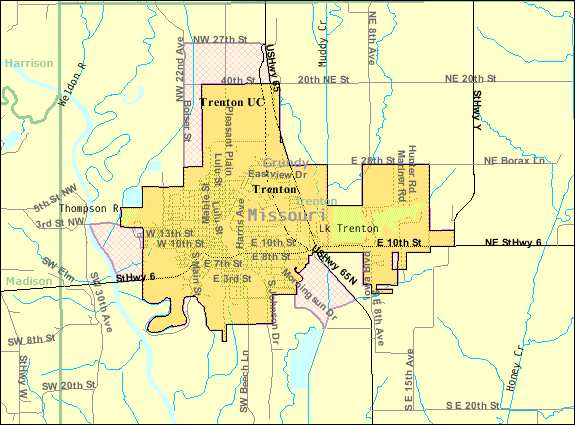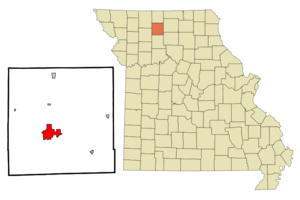- Trenton, Missouri
Infobox Settlement
official_name = Trenton, Missouri
settlement_type =City
nickname =
motto =
imagesize =
image_caption =
image_
imagesize =
image_caption =
image_
mapsize = 250px
map_caption = Location of Trenton, Missouri
mapsize1 = U.S. Census Map
map_caption1 = 250pxsubdivision_type = Country
subdivision_name =United States
subdivision_type1 = State
subdivision_name1 =Missouri
subdivision_type2 = County
subdivision_name2 = Grundy
government_footnotes =
government_type =
leader_title =
leader_name =
leader_title1 =
leader_name1 =
established_title =
established_date =unit_pref = Imperial
area_footnotes =
area_magnitude =
area_total_km2 = 15.9
area_land_km2 = 15.1
area_water_km2 = 0.8
area_total_sq_mi = 6.1
area_land_sq_mi = 5.8
area_water_sq_mi = 0.3population_as_of = 2000
population_footnotes =
population_total = 6216
population_density_km2 = 411.4
population_density_sq_mi = 1065.5timezone = Central (CST)
utc_offset = -6
timezone_DST = CDT
utc_offset_DST = -5
elevation_footnotes =
elevation_m = 256
elevation_ft = 840
latd = 40 |latm = 4 |lats = 42 |latNS = N
longd = 93 |longm = 36 |longs = 41 |longEW = Wpostal_code_type =
ZIP code
postal_code = 64683
area_code = 660
blank_name = FIPS code
blank_info = 29-73816GR|2
blank1_name = GNIS feature ID
blank1_info = 0727769GR|3
website =
footnotes =Trenton is a city in Grundy County,
Missouri ,United States . The population was 6,216 at the 2000 census. It is thecounty seat of Grundy CountyGR|6.The city claims to be the world's largest producer of
vienna sausage s (at its biggest employerConAgra Grocery Foods plant). [ [http://www.trentonmo.com/econ_employers.htm Major Employers - trentonmo.com - Retrieved February 19, 2008] ]History
Green Hills
Trenton was first settled in 1834 and was known as Lomax Store for the J.S. Lomax General Store on a bluff above the Thompson Branch of the
Grand River (Missouri) . It was renamed Bluff Grove and won a battle withTindall, Missouri to become the county seat ofGrundy County, Missouri . The hilly area today is called the "Green Hills." It was renamed again in 1842 in honor ofTrenton, New Jersey .The Chicago and Southwestern Railroad (which became part of the
Rock Island Line ) arrived in 1869. In 1890 Avalon College, which had been founded inAvalon, Missouri by the United Brethern in 1869 moved to Trenton because of proximity to the railroad. The College nearly closed again.The Utopian Ruskin College Movement
In 1900 George McAnelly Miller started to turn the school around. He was soon joined by
Walter Vrooman who had just returned fromOxford, England where he established Ruskin Hall, a university called the "College for the People" based on the Utopian writings ofJohn Ruskin . Avalon College was renamed Ruskin College after Vrooman donated convert|1500|acre|km2 to it.The college directly loaned money to the students and they could work at the school's canning, farming and novelty wood working businesses. The college admitted women (unlike the Oxford school). [ [http://whmc.umsystem.edu/invent/3803.html Ruskin College Material at the University of Missouri] ] [http://books.google.com/books?id=yrcYAAAAMAAJ&pg=PA16&dq=Trenton+Ruskin+College#PPA18,M1]
Vrooman then proceeded to attempt to buy the major businesses in the town buying three grocery stores, a hardware store, drug store -- paying for it all in cash via the Western Cooperative Association. The
New York Times on April 14, 1902 headlined its article on the development "Buying a Town Outright." According to the cooperative arrangement, members of the coop who spent at least $300 in one of its stores would receive a dividend at the end of the year.The Ruskin experiment collapsed in 1903 when town residents resisted the Utopian business model and Vrooman's wife divorced him saying that he had squandered $250,000 of her money. Miller moved the college to the Chicago suburb of
Glen Ellyn, Illinois in 1903 where it consolidated 12 different colleges and had an enrollment of 2,500 with 8,000 correspondence students. Friction quickly arose there also and the main school burned after being struck by lightning. [ [http://gothere.com/Florida/Ruskin/ Ruskin, Florida from gothere.com] ] .Miller moved the college again in 1906 to
Ruskin, Florida where convert|550|acre|km2 of land around Trenton was swapped for convert|12000|acre|km2. Many of the Florida campus buildings burned in 1918 and when Miller died in 1919, the College ceased to exist. [ [http://www.ruskinhistory.org/founding_of%20Ruskin.htm Founding of Ruskin, Florida - ruskinhistory.org - Retrieved October 12, 2007] ]In 1925, Trenton Junior College was established (which is now
North Central Missouri College )Historic visits
In 1915,
Arthur M. Hyde moved to Trenton and opened a law business and had theBuick dealership. Hyde would becomeMissouri Governor and thenUnited States Secretary of Agriculture underHerbert Hoover . Hoover stayed at Hyde's home in 1933 visit following his Presidency.In 1939 nationally famous track star
Jesse Owens came to Trenton to run promotional races against a variety of opponents such as a man on a horse, a man in a truck, as well as anyone who wanted to run against the Olympic Gold Medalist. These were short races giving a decided advantage to the very quick Owens over horses or vehicles. Arriving in Trenton by bus Owens entered the bus station/diner known as the Blue Moon Cafe and noticed a tent sign reserving the center table. Trenton was located in an area that had historically not had slaves or free African-Americans but was segregated as the norm of the time. Owens asked the proprietor, Lee Hathaway, "where do colored folk eat?" Hathaway explained the reserved table was for him. Owens stated that he preferred to eat "where coloreds usually ate". He and Hathaway shared dinner in the kitchen.The next day Owens raced on the track that is still used by Trenton High School.An early film maker was in town at the time making a promotional movie hi-lighting paying Trenton businesses. This movie was not a drama but a compilation of shots of various people and places. The producer included the Jesse Owens track event in the movie as well as every person possible by filming other public events. The resulting silent movie was shown later at a Trenton theater to the delight of hundreds of locals who had never seen themselves on the big screen before. Footage was restored in the 1980s by local judge Eric Sonic and copies made for area residents.
Rock Island Line Roundhouse
Trenton was home to a
Rock Island Railroad maintenance facility known as aroundhouse since 1900. The round house provided locomotive overhaul work for the Kansas City terminals and was a major employer for the Trenton area. A bitter strike in the 1940s pitted union workers against the railroad and scab labor who were still feeling the effects of the Great Depression. Strike breaking workers had to carry their tool boxes as they walked several miles to the round house. As a strike breaker named Hobbs walked across the bridge (now known as the Charlie Dye bridge) to Trenton in the early morning he encountered a group of striking union members drunk at the end of the bridge. He reached into his tool box and picked an item that would resemble a pistol and put it into his pocket. When he reached the thugs they jeered him but did not touch him since they had seen him put something in his pocket and he still had his hand on it. The next scab laborer that walked across the bridge was beaten to death.Local authorities were hesitant to prosecute. Politics favored the strikers and no one was punished for the murder. Rock Island executives were outraged. They settled the strike but closed the roundhouse, moving the overhaul base to Kansas City. The result was that the trend of slow population growth was reversed and Trenton has slowly declined in population since.
Leading Vienna Sausage producer
Pete Taylor owned a canning plant in nearby
Spickard, Missouri that canned tomatoes and other produce raised by local farmers. Taylor needed a cleaner water source than what Spickard could provide so he moved his operation to a building a half block south of the east end of the 17th Street bridge in Trenton. Taylor quickly out grew this building. He bought land to the east and began building the Trenton Foods Canning Plant. Taylor was bought out byCarnation (trademark) which was in turn was bought byNestle . In 1998 the plant was acquired byConAgra . The plant is the largest employer in the county and cans a variety of products including nacho cheese, chili, Vienna sausages, institutional foods, gravy, in theLibby's food line and other brands.uperfund Sites
Trenton has two hazardous waste dump sites. [ [http://www.cqs.com/super_mo.htm Missouri Superfund Sites - cqs.com - Retrieved February 27, 2008] ] One is on the property of Modine Manufacturing, a plant that makes automobile radiators. Modine has produced a variety of acid, lead, and cooper bearing waste products which in previous decades were buried on site and also at a public dump a mile north east of the plant.
Government
* Mayor: Cathie Smith
* First Ward Council Members : Terry Toms & Nick McHargue
* Second Ward Council Members: Kenneth Ewing & Steve Perry
* Third Ward Council Members: Ed Holt and Chuck Elliott
* Fourth Ward Council Members: David Trickel & Jim BushGeography
Trenton is located at coor dms|40|4|42|N|93|36|41|W|city (40.078230, -93.611436)GR|1. According to the
United States Census Bureau , the city has a total area of 6.1 square miles (15.9 km²), of which, 5.8 square miles (15.1 km²) of it is land and 0.3 square miles (0.8 km²) of it (4.74%) is water.Demographics
As of the
census GR|2 of 2000, there were 6,216 people, 2,673 households, and 1,641 families residing in the city. Thepopulation density was 1,065.5 people per square mile (411.7/km²). There were 3,059 housing units at an average density of 524.3/sq mi (202.6/km²). The racial makeup of the city was 97.20% White, 0.56% African American, 0.40% Native American, 0.21% Asian, 0.02% Pacific Islander, 0.74% from other races, and 0.87% from two or more races. Hispanic or Latino of any race were 2.14% of the population.There were 2,673 households out of which 25.6% had children under the age of 18 living with them, 49.0% were married couples living together, 9.4% had a female householder with no husband present, and 38.6% were non-families. 35.2% of all households were made up of individuals and 19.6% had someone living alone who was 65 years of age or older. The average household size was 2.19 and the average family size was 2.81.
In the city the population was spread out with 22.0% under the age of 18, 9.1% from 18 to 24, 23.0% from 25 to 44, 22.2% from 45 to 64, and 23.7% who were 65 years of age or older. The median age was 42 years. For every 100 females there were 83.7 males. For every 100 females age 18 and over, there were 80.4 males.
The median income for a household in the city was $25,733, and the median income for a family was $33,317. Males had a median income of $26,959 versus $16,505 for females. The
per capita income for the city was $15,834. About 12.7% of families and 17.1% of the population were below thepoverty line , including 23.2% of those under age 18 and 14.6% of those age 65 or over. Spickard is in the first percentile for average family income nationally.Fact|date=February 2008Notable natives and residents
*
Yank Lawson ,Dixieland trumpet player
*J. M. Whorton , PoliticianReferences
External links
* [http://www.trentonmo.com City of Trenton]
* [http://www.trentonmochamber.com Trenton Chamber of Commerce]
Wikimedia Foundation. 2010.


